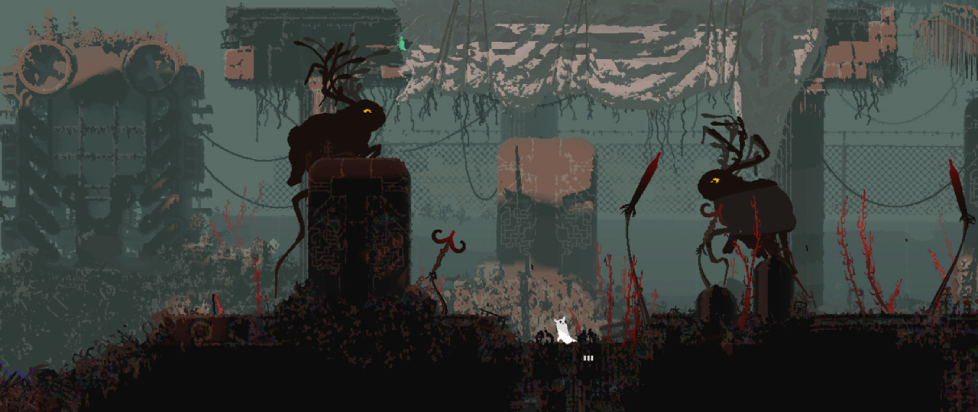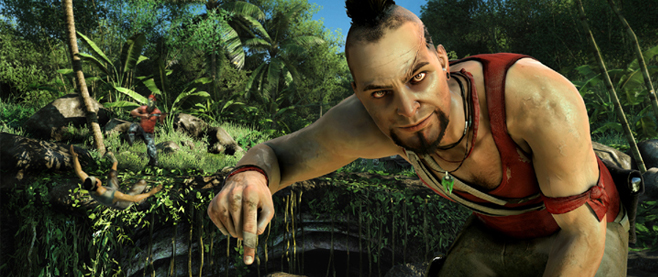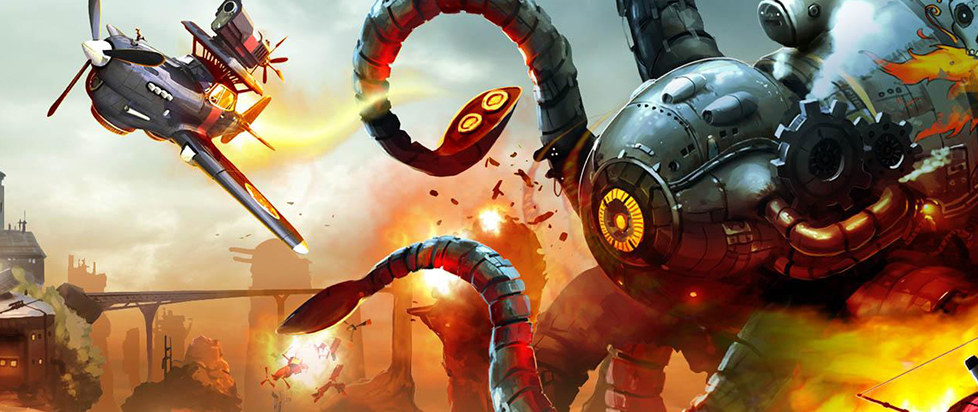
Making Peace in the Toothy Maw of Rain World
I am playing Rain World. I am thinking of stray dogs, and my hands are bleeding.
I am a small creature, crawling through a narrow dirt tunnel that stretches long underneath the creaking remains of an industrial graveyard. I pass creatures smaller still – flitting black bats and buzzing flies. Small stones litter the dirt like lost treasures, my tail tapping the sides of the tunnel with a mind of its own. After minutes spent wriggling on my belly in the soil, I finally emerge into the damp air. A pale green sky hangs overhead, home to great birds with dangling appendages and vines that cling to the surface of rusting infrastructure. Within mere seconds of my perky white ears erupting from their shelter, a waiting lizard sheds its camouflage and paralyzes my body with a hooked tongue. A single snap of its powerful jaw and I’m done for. I will perish many more times in the near future, crushed by gravity and rent by powerful limbs and drowned in dark waters, bruised and beaten and thrown away like so much detritus whose value is entirely derived from how many unique ways it can be perversely destroyed.
Rain World may be a beautiful game, but it is also a mean one, and its ability to find a large audience has suffered as a result, like a mangy dog who bites an outstretched hand, only to find itself hungry and shivering in the dark. This is the game’s cruelest trick, that it would attract curious players just to lose their interest in the opening hours when it’s at its nastiest, all low-throated growls and premature deaths. Those players will never see what happens when the hand that’s bitten continues to reach out, when dedication beyond reason transforms a wild beast into an intimate friend. Rain World does not deserve to be tamed, but I would sure like a companion anyway.
The premise of Rain World establishes the expectation of a beautiful journey amidst a strange land. Players assume the role of a slugcat wandering the Outskirts, a mess of old machinery honeycombed with dark tunnels, ostensibly in search of a lost family, but effectively in pursuit of fruit and flies to fill their belly. The detailed pixel art awards this environment a uniquely alien feel – simultaneously living and dead, ancient and newly born. Vivid shoots of grass twitch in the wind, watched over by barbed-wire fencing and the steel blades of long-dormant fans, while pillars of mysterious origin melt into a distant mist. For a few precious moments, the player’s attention may be entirely subsumed by the appearance of this living landscape.
However, the stunning introductory sheen does not last long, and a flash of teeth are seen the first time the slugcat dies. This death may be delivered by a lizard’s jaws, certainly. But just as likely, its source is both more mundane and terrifying, as the distant rumbling of a heavy storm grows closer every second, until those rumblings are suddenly not so distant and the rain begins to pour and it doesn’t stop until the water pools in deep recesses of the earth and fills the slugcat’s lungs, its little body drifting quietly in what is now an angry ocean. The hollow hit of a single drum rings out, a waterlogged world slowly blurring into darkness. This callous presentation of death suggests an amused, if uncaring presence – bright eyes lazily watching from the shadows.

Thus, the slugcat finds themself desperately treading water, pulled down by the needy demands of survival. To save the game and make progress, they must find a hibernation pod, having first eaten enough food to last through their long slumber. To find food, they must explore a horrifically dangerous environment, outing themself not only as a desperate predator but easy prey, wandering a maze that hides a minotaur in each dead end and yanks the fabled guiding twine further away with each step forward. And all of this must be done before the rains inevitably start to fall again. Failing to stay above the current provides new challenges, as the slugcat is not only sent back to their last checkpoint upon death, but “levels down”, the mysterious ranking that opens access to new areas losing value with each successive death. The game’s nature is revealed to be not just apathetic, but actively malicious, punishing failure with a swift bite on an already-bleeding wound. Die from a threat I couldn’t have avoided, wake up in the dark earth weaker than ever, and emerge directionless in the blind hope that I will find enough food to fill my belly, beaten down so badly to forget about the purpose of this damned journey in the first place. If this game ever had a guiding hand, it was surely torn to pieces by sharp teeth.
After experiencing Rain World’s unforgiving cycle of death and punishment, it is not only understandable but anticipated that players would get fed up with the abuse and walk away to games that welcome their time and attention with any amount of appreciation. Why, then, do some players stay? Why do they continue to wriggle forward through the maze of dark tunnels and hungry mouths? Why do they reach out to pet the beast that bites them?
When I was a teenager, I had a shelter dog. He was skittish and a bit mean, uprooted and shuffled from home to temporary home, hands that held him only briefly before letting go. I was not offended at the sight of bared teeth and raised hackles. Who was I to assume that my home might feel any different, that this poor creature would think my hands to be the ones that hold him gentle and close? Rain World is not a usual game, and neither is its relationship to the player. It is a howling, blinded, tick-ridden animal that simultaneously wants to be left alone forever and never be alone again. The most committed players understand this on some level – they are not submitting to an experience, but rather asking that experience to submit to them. There is an instilled faith that if they can just break through the harsh surface, fill their bellies with food and find somewhere safe to sleep, something – anything – will be waiting for them when they wake up. It’s a radical kindness to tame Rain World, and one that is not rewarded quickly.

Eventually the slugcat will break free from the Outskirts, their travels spilling out to increasingly strange limbs of an already unusual world – dark citadels and twisting rivers and silent plains broken only by the crack of thunder overhead. Each new area offers a plethora of sensory experience, flora and fauna whose demeanor and roles are yet unknown – a new series of challenges to tackle, yes, but also new ways to interact with the world, continuing a relationship whose take is finally starting to give back through moments of peace amidst the punishment. For every hollow ringing of death’s drum, a bulb of clear water drips from stalactites to the bowels of old industry, critters scamper over bluffs that see no sun, clouds shiver at the peak of the world. A glimpse of wagging tail is just barely caught each time the slugcat meets a friendly creature, a whiff of warm breath felt when it sits on a silent shore to watch the waves break. Each death that once felt so meaningless begins to contribute not only to the player’s understanding of the gameplay, but a larger reassurance that they were indeed correct –there really is something special under the surface, a bristled mane giving way to soft fur.
The nature of the game begins to change – it is still mean and nasty, it still bites the fingers that stray too far along its matted fur, deaths still result in an unforgiving loss of progress. But those fingers can now remain a touch longer, bright eyes betraying a hint of excitement at no longer being so alone. Those players who care the most may eventually reach the end of Rain World. The slugcat, weary and wizened, finally joins their lost family deep under the earth and hibernates for the last time. No low-throated growls, no warning glares, just dull eyes and a cold coat. A world has been traveled, a family reunited, a belly full of fruit and flies… and where does that leave the player? Where does that leave me, who has spent all this time building a relationship just for it to end?
When starting a new game, players have come to anticipate a certain amount of reassurance from the experience, to be placed in the guiding hands of a figure of authority. It is no surprise, then, that Rain World’s curled lips and confused growls come as a shock. But to mistake this anxious threat for cruelty would be a damn shame. I no longer have that shelter dog – my dad gave him away after a messy divorce, but not before the dog began to trot to my room every night to lie on top of my covers, a furry head butting under my hand in an ingenious plot to be held. I don’t play Rain World anymore, and that dog doesn’t trot up to my bed at night, but I sure think about both a lot. No love is ever truly lost, no relationship a waste. Whether it graces sharp teeth or soft fur, the hand that reaches out will always be better off for having done so.
———
Hayes is studying game design and technical art at the University of Utah. You can find more of his ramblings here.





